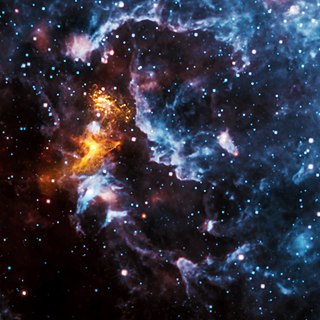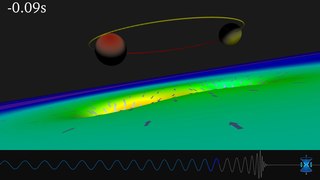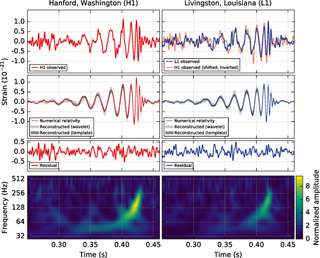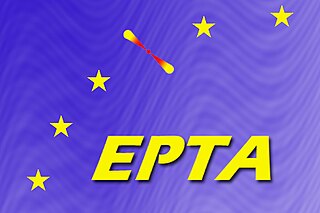Related Research Articles

A neutron star is the collapsed core of a massive supergiant star, which had a total mass of between 10 and 25 solar masses (M☉), possibly more if the star was especially metal-rich. Except for black holes, neutron stars are the smallest and densest known class of stellar objects. Neutron stars have a radius on the order of 10 kilometers (6 mi) and a mass of about 1.4 M☉. They result from the supernova explosion of a massive star, combined with gravitational collapse, that compresses the core past white dwarf star density to that of atomic nuclei.

The Laser Interferometer Space Antenna (LISA) is a proposed space probe to detect and accurately measure gravitational waves—tiny ripples in the fabric of spacetime—from astronomical sources. LISA would be the first dedicated space-based gravitational-wave observatory. It aims to measure gravitational waves directly by using laser interferometry. The LISA concept has a constellation of three spacecraft arranged in an equilateral triangle with sides 2.5 million kilometres long, flying along an Earth-like heliocentric orbit. The distance between the satellites is precisely monitored to detect a passing gravitational wave.

Einstein@Home is a volunteer computing project that searches for signals from spinning neutron stars in data from gravitational-wave detectors, from large radio telescopes, and from a gamma-ray telescope. Neutron stars are detected by their pulsed radio and gamma-ray emission as radio and/or gamma-ray pulsars. They also might be observable as continuous gravitational wave sources if they are rapidly spinning and non-axisymmetrically deformed. The project was officially launched on 19 February 2005 as part of the American Physical Society's contribution to the World Year of Physics 2005 event.

A pulsar is a highly magnetized rotating neutron star that emits beams of electromagnetic radiation out of its magnetic poles. This radiation can be observed only when a beam of emission is pointing toward Earth, and is responsible for the pulsed appearance of emission. Neutron stars are very dense and have short, regular rotational periods. This produces a very precise interval between pulses that ranges from milliseconds to seconds for an individual pulsar. Pulsars are one of the candidates for the source of ultra-high-energy cosmic rays.

The Crab Pulsar is a relatively young neutron star. The star is the central star in the Crab Nebula, a remnant of the supernova SN 1054, which was widely observed on Earth in the year 1054. Discovered in 1968, the pulsar was the first to be connected with a supernova remnant.

A millisecond pulsar (MSP) is a pulsar with a rotational period less than about 10 milliseconds. Millisecond pulsars have been detected in radio, X-ray, and gamma ray portions of the electromagnetic spectrum. The leading theory for the origin of millisecond pulsars is that they are old, rapidly rotating neutron stars that have been spun up or "recycled" through accretion of matter from a companion star in a close binary system. For this reason, millisecond pulsars are sometimes called recycled pulsars.

PSR J0737−3039 is the first known double pulsar. It consists of two neutron stars emitting electromagnetic waves in the radio wavelength in a relativistic binary system. The two pulsars are known as PSR J0737−3039A and PSR J0737−3039B. It was discovered in 2003 at Australia's Parkes Observatory by an international team led by the Italian radio astronomer Marta Burgay during a high-latitude pulsar survey.
The gravitational wave background is a random background of gravitational waves permeating the Universe, which is detectable by gravitational-wave experiments, like pulsar timing arrays. The signal may be intrinsically random, like from stochastic processes in the early Universe, or may be produced by an incoherent superposition of a large number of weak independent unresolved gravitational-wave sources, like supermassive black-hole binaries. Detecting the gravitational wave background can provide information that is inaccessible by any other means, about astrophysical source population, like hypothetical ancient supermassive black-hole binaries, and early Universe processes, like hypothetical primordial inflation and cosmic strings.

A binary pulsar is a pulsar with a binary companion, often a white dwarf or neutron star. Binary pulsars are one of the few objects which allow physicists to test general relativity because of the strong gravitational fields in their vicinities. Although the binary companion to the pulsar is usually difficult or impossible to observe directly, its presence can be deduced from the timing of the pulses from the pulsar itself, which can be measured with extraordinary accuracy by radio telescopes.
Dale A. Frail is a Canadian astronomer working at the National Radio Astronomy Observatory (NRAO) in Socorro, New Mexico.

Gravitational waves are waves of the intensity of gravity that are generated by the accelerated masses of binary stars and other motions of gravitating masses, and propagate as waves outward from their source at the speed of light. They were first proposed by Oliver Heaviside in 1893 and then later by Henri Poincaré in 1905 as the gravitational equivalent of electromagnetic waves.

A gravitational-wave detector is any device designed to measure tiny distortions of spacetime called gravitational waves. Since the 1960s, various kinds of gravitational-wave detectors have been built and constantly improved. The present-day generation of laser interferometers has reached the necessary sensitivity to detect gravitational waves from astronomical sources, thus forming the primary tool of gravitational-wave astronomy.

Gravitational-wave astronomy is an emerging field of science, concerning the observations of gravitational waves to collect relatively unique data and make inferences about objects such as neutron stars and black holes, events such as supernovae, and processes including those of the early universe shortly after the Big Bang.

In cosmology, primordial black holes (PBHs) are hypothetical black holes that formed soon after the Big Bang. In the inflationary era and early radiation-dominated universe, extremely dense pockets of subatomic matter may have been tightly packed to the point of gravitational collapse, creating primordial black holes without the supernova compression needed to make black holes today. Because the creation of primordial black holes would pre-date the first stars, they are not limited to the narrow mass range of stellar black holes.
A pulsar timing array (PTA) is a set of galactic pulsars that is monitored and analysed to search for correlated signatures in the pulse arrival times on Earth. As such, they are galactic-sized detectors. Although there are many applications for pulsar timing arrays, the best known is the use of an array of millisecond pulsars to detect and analyse long-wavelength gravitational wave background. Such a detection would entail a detailed measurement of a gravitational wave (GW) signature, like the GW-induced quadrupolar correlation between arrival times of pulses emitted by different millisecond pulsar pairings that depends only on the pairings' angular separations in the sky. Larger arrays may be better for GW detection because the quadrupolar spatial correlations induced by GWs can be better sampled by many more pulsar pairings. With such a GW detection, millisecond pulsar timing arrays would open a new low-frequency window in gravitational-wave astronomy to peer into potential ancient astrophysical sources and early Universe processes, inaccessible by any other means.

The European Pulsar Timing Array (EPTA) is a European collaboration to combine five 100-m class radio-telescopes to observe an array of pulsars with the specific goal of detecting gravitational waves. It is one of several pulsar timing array projects in operation, and one of the four projects comprising the International Pulsar Timing Array, the others being the Parkes Pulsar Timing Array, the North American Nanohertz Observatory for Gravitational Waves, and the Indian Pulsar Timing Array.

BICEP and the Keck Array are a series of cosmic microwave background (CMB) experiments. They aim to measure the polarization of the CMB; in particular, measuring the B-mode of the CMB. The experiments have had five generations of instrumentation, consisting of BICEP1, BICEP2, the Keck Array, BICEP3, and the BICEP Array. The Keck Array started observations in 2012 and BICEP3 has been fully operational since May 2016, with the BICEP Array beginning installation in 2017/18.
The North American Nanohertz Observatory for Gravitational Waves (NANOGrav) is a consortium of astronomers who share a common goal of detecting gravitational waves via regular observations of an ensemble of millisecond pulsars using the Green Bank Telescope, Arecibo Observatory, and the Very Large Array. This project is being carried out in collaboration with international partners in the Parkes Pulsar Timing Array in Australia, the European Pulsar Timing Array, and the Indian Pulsar Timing Array as part of the International Pulsar Timing Array.

PSR J0348+0432 is a pulsar–white dwarf binary system in the constellation Taurus. It was discovered in 2007 with the National Radio Astronomy Observatory's Robert C. Byrd Green Bank Telescope in a drift-scan survey.

Chiara Mingarelli is an Italian-Canadian astrophysicist who researches gravitational waves. She is an assistant professor of physics at Yale University since 2023, and previously an assistant professor at the University of Connecticut (2020–2023). She is also a science writer and communicator.
References
- ↑ Hobbs, G.; et al. (2010). "The International Pulsar Timing Array project: using pulsars as a gravitational wave detector". Class. Quantum Grav. 27 (8): 084013. arXiv: 0911.5206 . Bibcode:2010CQGra..27h4013H. doi:10.1088/0264-9381/27/8/084013. S2CID 56073764. 084013.
- ↑ Joshi, Bhal Chandra; Gopakumar, Achamveedu; Pandian, Arul; Prabu, Thiagaraj; Dey, Lankeswar; Bagchi, Manjari; Desai, Shantanu; Tarafdar, Pratik; Rana, Prerna; Maan, Yogesh; BATRA, Neelam Dhanda; Girgaonkar, Raghav; Agarwal, Nikita; Arumugam, Paramasivan; Basu, Avishek (2022-12-08). "Nanohertz gravitational wave astronomy during SKA era: An InPTA perspective". Journal of Astrophysics and Astronomy. 43 (2): 98. arXiv: 2207.06461 . Bibcode:2022JApA...43...98J. doi:10.1007/s12036-022-09869-w. ISSN 0973-7758. S2CID 250526806.
- ↑ Tarafdar, Pratik; Nobleson, K.; Rana, Prerna; Singha, Jaikhomba; Krishnakumar, M. A.; Joshi, Bhal Chandra; Paladi, Avinash Kumar; Kolhe, Neel; Batra, Neelam Dhanda; Agarwal, Nikita; Bathula, Adarsh; Dandapat, Subhajit; Desai, Shantanu; Dey, Lankeswar; Hisano, Shinnosuke (January 2022). "The Indian Pulsar Timing Array: First data release". Publications of the Astronomical Society of Australia. 39: e053. arXiv: 2206.09289 . Bibcode:2022PASA...39...53T. doi:10.1017/pasa.2022.46. ISSN 1323-3580. S2CID 249889663.
- ↑ National Research Council of the National Academy of Sciences (2011). Panel reports—New Worlds, New Horizons in Astronomy and Astrophysics. Washington, D.C.: National Academies Press. ISBN 978-0-309-15962-3.
- ↑ Verbiest, J. P. W.; Lentati, L.; Hobbs, G.; van Haasteren, R.; Demorest, P. B.; Janssen, G. H.; Wang, J. -B.; Desvignes, G.; Caballero, R. N.; Keith, M. J.; Champion, D. J.; Arzoumanian, Z.; Babak, S.; Bassa, C. G.; Bhat, N. D. R.; Brazier, A.; Brem, P.; Burgay, M.; Burke-Spolaor, S.; Chamberlin, S. J.; Chatterjee, S.; Christy, B.; Cognard, I.; Cordes, J. M.; Dai, S.; Dolch, T.; Ellis, J. A.; Ferdman, R. D.; Fonseca, E.; et al. (2016). "The International Pulsar Timing Array: First Data Release". Monthly Notices of the Royal Astronomical Society. 458 (2): 1267–1288. arXiv: 1602.03640 . Bibcode:2016MNRAS.458.1267V. doi:10.1093/mnras/stw347. S2CID 4684500.
- ↑ Perera, B. B. P.; et al. (2019-12-21). "The International Pulsar Timing Array: Second data release". Monthly Notices of the Royal Astronomical Society. 490 (4): 4666–4687. arXiv: 1909.04534 . doi:10.1093/mnras/stz2857. ISSN 0035-8711.
- ↑ Castelvecchi, Davide (2022-01-27). "Astronomers close in on new way to detect gravitational waves". Nature. 602 (7896): 194–195. Bibcode:2022Natur.602..194C. doi:10.1038/d41586-022-00170-y. PMID 35087253. S2CID 246360299.